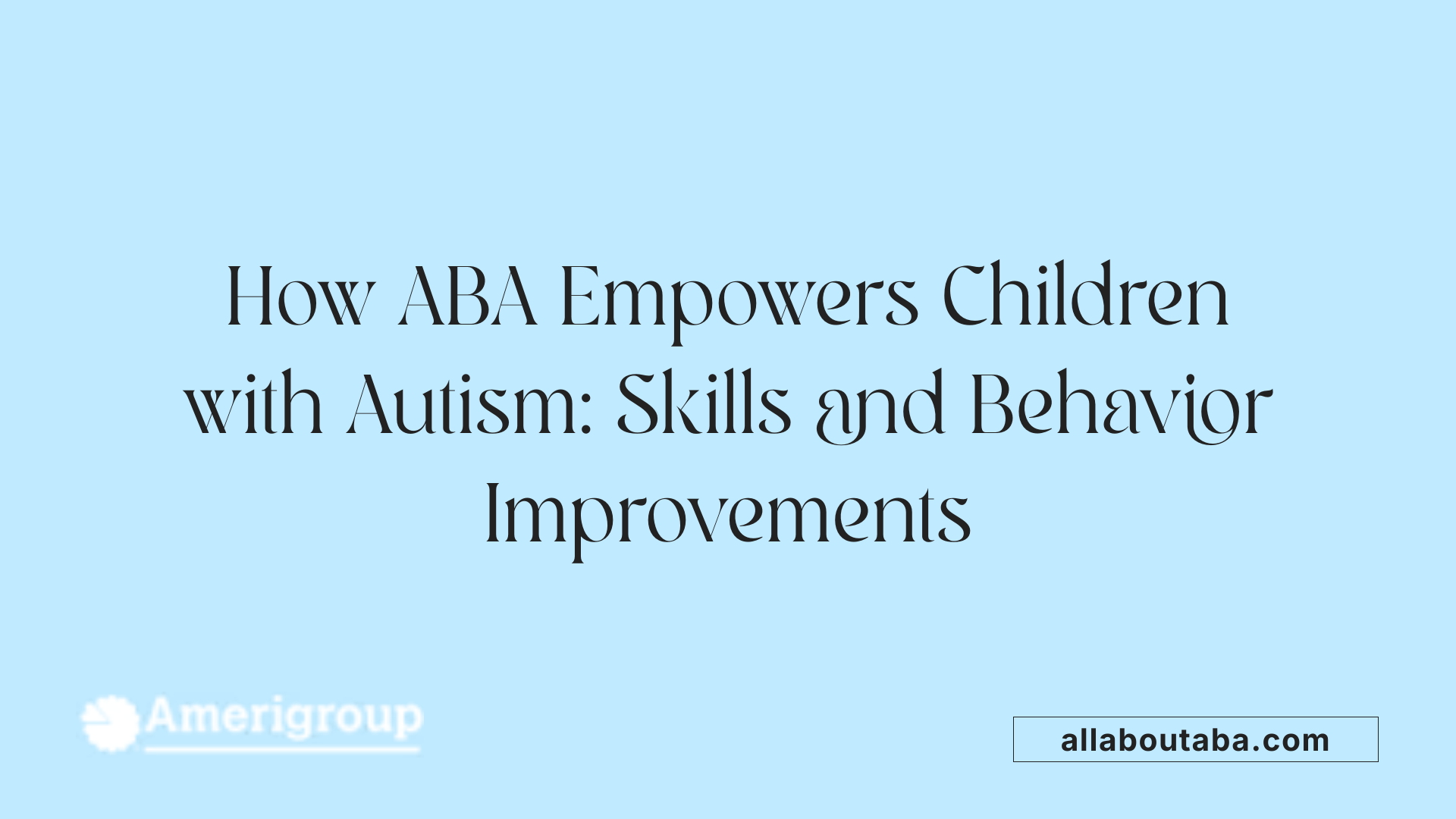Autism And Goal Setting For Personal Growth
Understanding the Role of Goal Setting in Autism Therapy
Applied Behavior Analysis (ABA) therapy is recognized as a leading treatment approach for individuals with autism spectrum disorder (ASD). Central to ABA’s success is the strategic use of goal setting to promote personal growth and skill development. This article explores how precise, individualized goals contribute to the transformative progress seen in those receiving ABA therapy, highlighting key methods, collaborations, and outcomes associated with this evidence-based practice.
What is Applied Behavior Analysis (ABA) Therapy?

Definition and Purpose of ABA Therapy
Applied Behavior Analysis (ABA) therapy is a scientifically supported treatment designed to improve socially significant behaviors. It focuses on enhancing skills such as communication, social interaction, and daily living abilities while reducing problematic behaviors that may hinder personal development. ABA is especially well-known for its effectiveness in supporting children with autism spectrum disorder (ASD).
Behavioral Principles Underlying ABA
At its core, ABA is based on behaviorism, which studies the relationship between behaviors and their environment. Therapists analyze behavior using the ABC model—Antecedent, Behavior, and Consequence—to understand what triggers and reinforces specific actions. This understanding forms the foundation for modifying behaviors using structured and consistent methods.
Role of Behavior Analysis and Reinforcement Techniques
One of the central techniques in ABA is positive reinforcement, where desired behaviors are encouraged through rewards or praise. Other strategies include Discrete Trial Training (DTT), Natural Environment Training (NET), and modeling, all tailored to help individuals learn and retain new skills. These techniques work together to build and maintain meaningful improvements in behavior.
Individualization and Program Customization
ABA therapy is highly personalized. Therapists conduct thorough assessments to identify each individual's strengths and challenges, then establish specific, measurable goals that follow the SMART framework—Specific, Measurable, Achievable, Relevant, and Time-bound. Goals are divided into smaller, manageable steps to promote steady progress. Additionally, ongoing data collection and collaboration with parents and caregivers ensure that programs remain effective and adjustable as needs evolve.
Who Provides ABA Therapy and Where?

Who provides ABA therapy?
ABA therapy is delivered by a team of qualified professionals dedicated to supporting children with autism spectrum disorder. Central to the delivery are Board Certified Behavior Analysts (BCBAs), who develop and oversee personalized treatment plans tailored to each child's unique needs.
Registered Behavior Technicians (RBTs) or other trained therapists implement these plans through direct therapy sessions, working closely under the guidance of a BCBA. This approach ensures that therapy remains consistent, focused, and evidence-based.
ABA therapy takes place in a variety of settings to best support the child’s learning environment. Common locations include the family’s home, schools, developmental preschools, and community centers. Therapy can be administered on a one-on-one basis or in small groups depending on the goals and context.
Specialized companies also play a vital role by providing ABA therapy services. These organizations often supply teams of professionals and resources dedicated to behavioral interventions specifically for children with autism.
Family involvement is another crucial element. Parents and caregivers are actively engaged in training sessions and progress discussions, which helps generalize learned skills across different environments and daily routines.
This integrated approach combining expert therapists, diverse settings, professional agencies, and family participation maximizes the effectiveness of ABA therapy and fosters meaningful development for children with ASD.
How ABA Therapy Supports Individuals with Autism

How does ABA therapy help individuals with autism?
ABA therapy helps individuals with autism by using scientifically supported techniques to foster new skills and reduce challenging behaviors. By focusing on measurable and achievable goals, therapists work to enhance communication, social interaction, and daily living abilities. This approach targets helpful behaviors and decreases those that hinder learning or social engagement.
Improving communication and social skills
ABA uses methods such as the Picture Exchange Communication System (PECS), modeling, and functional communication training (FCT) to boost communication abilities. Social skills are developed through role-playing, social stories, and learning social cues, helping children better navigate social interactions and form meaningful relationships.
Reducing problematic behaviors
Aggression, tantrums, self-stimulatory behaviors, and sensory issues can present significant challenges for children with autism. ABA addresses these concerns by performing thorough assessments, like the Functional Behavior Assessment (FBA), and then applying targeted interventions based on positive reinforcement. This process encourages replacement of problematic behaviors with appropriate alternatives.
Customization and evidence-based techniques
Every ABA program is personalized through comprehensive assessments such as VB-MAPP and ABLLS-R, ensuring goals are tailored to the individual’s needs. Therapists employ techniques like Discrete Trial Training (DTT), Natural Environment Training (NET), and consistent positive reinforcement. Progress is monitored through regular data collection, allowing adjustments to maintain effectiveness.
Long-term benefits and quality of life improvements
Early and intensive ABA therapy supports significant enhancements in language, social skills, independence, and overall quality of life. With active involvement from parents and caregivers, ongoing collaboration ensures continued progress. Developmental preschools combined with ABA further nurture personal growth and life skills critical for community participation and self-care.
| Focus Area | ABA Strategies | Outcome |
|---|---|---|
| Communication | PECS, FCT, modeling | Improved expressive and receptive communication |
| Social Skills | Role-playing, social stories | Better social understanding and interactions |
| Problematic Behaviors | FBA, positive reinforcement | Reduced aggression, tantrums, and self-stimulation |
| Life Skills | Functional assessments, individualized programs | Enhanced independence and daily living abilities |
The Science of Goal Setting in ABA Therapy

Why Are Specific, Measurable Goals Important?
ABA therapy thrives on clear and tailored objectives. Setting specific and measurable goals ensures that each target skill or behavior is well-defined, making progress easier to track. This clarity helps therapists and families focus efforts effectively, leading to meaningful improvements across communication, social skills, academic abilities, behavior, and daily living tasks.
How Are Functional and Skills Assessments Used?
Accurate goal setting starts with comprehensive evaluations. Functional Behavior Assessment (FBA) analyzes the reasons behind behaviors, particularly problematic ones. Meanwhile, skills assessments such as the VB-MAPP and ABLLS-R identify current skill levels in vital areas like verbal behavior and adaptive skills. These tools guide therapists in creating goals that meet the child's unique needs.
How Does the SMART Framework Apply to Goal Setting?
Goals in ABA must be Specific, Measurable, Achievable, Relevant, and Time-bound (SMART). This approach ensures each objective is clear, trackable, realistically attainable, meaningful to the child’s development, and set within a timeframe. Adhering to SMART criteria helps maintain motivation and enables consistent evaluation.
Why Break Goals Into Manageable Steps?
Large goals can be overwhelming. By dividing objectives into smaller, incremental steps, children can achieve success progressively. This breakdown supports steady skill acquisition and builds confidence through regular accomplishments. Therapists tailor these steps to the individual’s pace, ensuring consistent growth without discouragement.
Techniques for Implementing Goals in ABA Programs
Discrete Trial Training (DTT) and Natural Environment Training (NET)
ABA therapy employs specific strategies to help children with autism achieve their personalized goals. Discrete Trial Training (DTT) breaks down skills into small, structured steps taught one at a time, allowing focused learning with immediate feedback. Conversely, Natural Environment Training (NET) encourages learning within real-world settings, using everyday activities to practice skills, making learning more natural and applicable.
Use of Positive Reinforcement
Central to ABA is positive reinforcement, where desirable behaviors are immediately rewarded with praise, tokens, or other incentives. This encourages repetition of good behaviors and helps shape new skills effectively. Reinforcers are tailored to each child's preferences, making the learning process motivating and enjoyable.
Additional Tools Such as Modeling and PECS
Other useful techniques include modeling, where therapists demonstrate a behavior for the child to imitate, fostering skill acquisition through observation. The Picture Exchange Communication System (PECS) is another tool that helps children develop communication by exchanging pictures to express needs and ideas, especially beneficial for nonverbal or minimally verbal children.
Functional Communication Training and Social Skills Development
Functional Communication Training (FCT) aims to reduce challenging behaviors by teaching children appropriate ways to communicate their needs. Social skills development involves role-playing, social stories, and learning to recognize social cues, which help children improve their interactions and relationships with others. These approaches ensure that communication and social goals are effectively met within ABA therapy programs.
Tracking Progress and Adapting Goals for Continued Growth

How is regular data collection and monitoring conducted in ABA therapy?
Regular data collection is a crucial component of ABA therapy. Therapists systematically gather detailed information on a child’s performance during sessions, often using data sheets or digital tools. This consistent monitoring allows for tracking progress toward set goals, such as improvements in communication or social skills. Techniques like Discrete Trial Training (DTT) involve structured sessions where precise measurements of success are recorded.
Why is adjusting goals based on progress important?
ABA goals are designed using the SMART framework, making them measurable and achievable. As therapy progresses, these goals are regularly reviewed and modified to match the child’s current abilities and challenges. If a child masters a task quickly, goals may be advanced or expanded. Conversely, if difficulties arise, goals can be broken down into smaller steps to support incremental improvement without frustration.
What role does collaboration between therapists and families play?
Parents and caregivers are vital partners in the therapy process. They participate in assessments, support reinforcement at home, and help collect data to provide a complete picture of the child's progress. Ongoing communication between therapists and families ensures consistency and helps tailor interventions to the child’s evolving needs. This collaboration enhances the effectiveness of ABA strategies outside clinical settings.
How does ongoing reassessment contribute to ABA therapy?
Functional Behavior Assessments (FBA) and skill evaluations like VB-MAPP and ABLLS-R are periodically repeated. Ongoing reassessment helps identify new strengths and challenges, informing necessary adjustments to the therapy plan. This cyclical process ensures that ABA therapy remains personalized and dynamic, maximizing growth opportunities for children with ASD.
The Vital Role of Families in Goal Setting and Therapy Success

Why is parental involvement crucial in ABA therapy assessments and reinforcement?
Parents play a fundamental role throughout the ABA therapy process. They participate in comprehensive assessments, such as Functional Behavior Assessment (FBA) and skills evaluations like the VB-MAPP and ABLLS-R. This engagement helps therapists create individualized goals that are realistic and relevant to the child’s everyday environment.
Moreover, parents are vital collaborators in reinforcing positive behaviors outside therapy sessions. By providing consistent positive reinforcement through rewards and praise at home, parents help solidify skills learned during therapy.
How are families trained to support therapy at home?
ABA therapists provide families with training to implement behavior strategies effectively between sessions. This training may include teaching parents how to carry out Discrete Trial Training (DTT) techniques, apply natural environment training (NET), and use communication tools such as Picture Exchange Communication System (PECS).
Equipping families with these skills ensures therapy goals are supported continuously, making progress more consistent and meaningful.
How does collaboration shape personalized treatment?
Collaboration between therapists and families is a continuous process. Regular reassessments involve input from parents to adjust goals and methods to the child’s evolving needs. This teamwork ensures that personalized treatment remains relevant, achievable, and sensitive to real-life scenarios encountered by the child.
What impact does family participation have on therapy outcomes?
Research and practical experience highlight that active family participation significantly improves outcomes. When parents are involved in goal-setting, reinforcement, and ongoing communication with therapists, children benefit from a cohesive support system. This synergy accelerates gains in communication, social skills, behavior management, and daily living abilities.
In essence, family involvement transforms ABA therapy from a clinical process into a dynamic collaboration that fosters lasting success for children with autism spectrum disorder.
Fostering Personal Growth Beyond Therapy Goals
How does ABA therapy support the development of life skills?
ABA therapy extends beyond addressing immediate behavioral challenges by honing essential life skills. Through tailored functional assessments and individualized programs, therapy targets self-care abilities, such as dressing and hygiene, and daily routines that contribute to greater autonomy. This structured approach equips children with autism spectrum disorder (ASD) with the tools they need to manage everyday tasks effectively.
In what ways does ABA promote independence and community participation?
Promoting independence is a primary objective of ABA therapy. By breaking down complex tasks into manageable steps and using techniques like positive reinforcement, therapists help children gradually master critical skills that foster self-reliance. Additionally, therapeutic goals often include community participation, encouraging children to engage confidently in social settings, navigate public environments, and build connections outside of the home.
How do social skills training and developmental preschools integrate with ABA therapy?
ABA therapy complements social skills training through role-playing, social stories, and instruction on recognizing social cues, all designed to enhance social interactions. When combined with developmental preschools, this approach supports holistic growth — facilitating communication, personal development, and life skills acquisition in an enriching, supportive environment. Together, they create a solid foundation for social competence and academic readiness.
What are the long-term benefits of fostering personal growth through ABA therapy?
By focusing on personal growth alongside specific therapy goals, ABA therapy empowers children with ASD for lifelong success. This comprehensive focus not only improves immediate behaviors but also builds enduring independence, social confidence, and community involvement. Ultimately, this approach enhances overall quality of life, maximizing each child’s potential and supporting sustained developmental progress.
Future Perspectives: Enhancing Goal Setting and Autism Support
Advances in assessment tools and techniques
The future of ABA therapy is witnessing continual improvements in assessment methods. Enhanced tools like updated Functional Behavior Assessments (FBA), and refined skill assessments such as VB-MAPP and ABLLS-R allow for more precise evaluation of children's current abilities and challenges. This precision enables therapists to tailor goals with even greater accuracy, ensuring interventions address the child's most critical needs.
Innovations in individualized programming
Moving forward, individualized programming in ABA is integrating cutting-edge strategies that break down goals into even smaller, manageable steps. These innovations offer a more customized approach, adapting dynamically to the child's learning pace and preferences. Techniques like Discrete Trial Training (DTT) and Natural Environment Training (NET) are being refined to further engage children and create natural learning opportunities.
Increasing accessibility and family-centered approaches
Accessibility remains a significant focus as ABA therapy expands. Future models emphasize family-centered care by involving parents more deeply in the assessment, goal-setting, and progress monitoring processes. Enhanced training resources and virtual coaching opportunities empower families to reinforce goals at home effectively, bridging gaps between therapy sessions.
The evolving role of technology and collaboration
Technology is transforming how ABA therapy delivers and tracks interventions. Digital data collection tools allow real-time tracking of progress, facilitating timely adjustments to goals and strategies. Collaboration platforms are fostering stronger communication between therapists, families, and educators, promoting a unified approach to support the child's development.
These advancements collectively promise improved outcomes in social, communication, academic, and life skills development for children with autism spectrum disorder, underscoring the evolving landscape of ABA therapy and goal setting.
Maximizing Potential Through Collaborative Goal Setting
Effective goal setting within ABA therapy provides a structured pathway to meaningful progress for individuals with autism. By setting clear, tailored objectives and actively involving families and professionals, the therapy fosters development across communication, social, behavioral, and daily living skills. Continuous assessment and adaptation ensure responsiveness to individual needs, supporting lasting personal growth. This collaborative approach is a cornerstone in empowering individuals with autism to lead more independent, fulfilling lives, highlighting the indispensable role of goal-oriented therapy in the broader context of autism support.
References
- How to Set ABA Goals: A Step-by-Step Guide for Success
- The Power of Progress: Applied Behavior Analysis (ABA) ...
- Applied Behavior Analysis (ABA)
- Board Certified Behavior Analysts (BCBA)
- Applied Behavior Analysis (ABA)
- 6 Benefits of ABA Therapy for Children with Autism
- Applied Behavior Analysis (ABA)
- Applied Behavior Analysis (ABA) for Children With Autism
Other articles
Recent articles

How To Support Autistic Students During Exam Season

Autism And Goal Setting For Personal Growth

How To Use Gamification In Autism Learning Programs

How Schools Can Reduce Bullying Of Autistic Students

Early Intervention Strategies For Autism Spectrum Disorder

The Role Of Therapists In Autism Life Skills Coaching

How To Support Autistic Individuals In Crisis Situations

Autism And Self-Care Routines For Stress Management

Understanding Echolalia And Its Role In Autism Communication

Autism And Fine Arts Education Benefits

The Impact Of Multisensory Learning On Autism Education

How Family Counseling Supports Autism Household Dynamics

Best Practices For Inclusive Playgrounds For Autism

Best Practices For Autism-Friendly Shopping Centers

How Autism Affects Fine Motor Skill Development

Best Ways To Introduce Sensory Activities Into Daily Routines

How Sports Teams Can Be Inclusive Of Autistic Players

Autism And Strategies For Building Workplace Resilience

Autism And The Impact Of Hormonal Changes During Puberty

How To Support Autistic Students In Foreign Language Classes

Best Ways To Teach Money Skills To Teens With Autism

Supporting Siblings Of Children With Autism

Autism And Co-Occurring Gastrointestinal Disorders

The Role Of Art Projects In Autism Sensory Integration

How Schools Can Incorporate Sensory Break Spaces

Best Practices For Autism Sensory Regulation At School

Autism And Strategies For Teaching Organizational Skills

Understanding The Relationship Between Autism And Anxiety Disorders

Autism And Life Planning For Long-Term Care

Exploring Visual Supports In Autism Education

Ways To Encourage Social Interaction In Children With Autism

The Connection Between Autism And Dyscalculia

The Role Of Occupational Therapy In Transition Planning For Autism

The Role Of Physical Therapists In Autism Motor Skills Support

How To Teach Decision-Making Skills To Autistic Young Adults

The Connection Between Autism And Epilepsy

Best Practices For Transitioning Autistic Children Into New Schools

Autism And Time Management Challenges In Adulthood

The Role Of Visual Arts In Autism Communication Development

How To Address Tactile Defensiveness In Autism

Best Practices For Telehealth Autism Therapy

How To Help Autistic Children Develop Friendship Skills

How Schools Can Support Autistic Students In Career Prep

Best Strategies For Autism-Friendly Event Planning

Understanding Noncontingent Reinforcement In Autism Behavior Plans

How Drama Therapy Benefits Autistic Individuals

Best Practices For Autism-Friendly Fitness And Recreation Centers

Best Ways To Promote Healthy Social Media Use For Autistic Teens

How To Help Autistic Children Cope With Public Speaking

Autism And Strategies For Managing Unexpected Changes

Best Podcasts About Autism For Parents And Educators

Autism And The Impact Of Seasonal Changes On Behavior

The Role Of Diet In Managing Co-Occurring Conditions With Autism

Sleep Challenges In Autism And Practical Solutions

Best Ways To Build Daily Routines For Autistic Children

Best Practices For Supporting Autistic Entrepreneurs

Autism And Strategies For Navigating Large Social Gatherings

Adaptive Sports And Recreational Activities For People With Autism

Autism And The Benefits Of Story-Based Learning Activities

Understanding The Role Of Play In Autism Development

Autism And The Impact Of Environmental Noise On Learning

How To Create Autism-Friendly Community Spaces

Autism And Chronic Health Conditions: What To Know

The Role Of Care Managers In Autism Life Planning

How To Teach Social Boundaries To Autistic Children

How Autistic Individuals Experience Empathy Differently

How To Support Autistic Employees In Remote Work Settings

Autism And The Relationship Between Motor Skills And Learning

How To Create Community Resource Guides For Autism Families

How To Teach Daily Living Skills To Autistic Teens

Autism And The Impact Of Mind-Body Practices On Stress Reduction

Autism And The Benefits Of Outdoor Group Activities

How To Create Autism-Friendly Sensory Paths In Schools

Best Practices For Autism-Friendly Park And Recreation Areas

Autism And Strategies For Reducing School Refusal

Supporting Autistic Individuals In Public Speaking

The Role Of Diet In Managing Autism Symptoms

The Benefits Of Gardening Clubs For Autism Social Development

How To Prepare Autistic Children For Dental Visits

Autism And Employment: Career Paths That Work

Best Practices For Autism-Friendly Hotels And Lodging

The Impact Of Screen Time On Autism Development

Autism Screening Tools For Early Childhood

The Role Of Physical Exercise In Autism Therapy

Best Strategies For Supporting Autistic College Students

The Role Of Technology In Autism Early Detection

Sensory-Friendly Classroom Design Ideas For Autistic Students

The Role Of Speech Therapy In Building Social Communication Skills

Best Strategies For Handling Autistic Burnout In Adults

Autism And The Importance Of Predictability In Routine

Autism And Peer Education: Teaching Acceptance In Schools

Best Practices For Sensory-Friendly Libraries And Reading Rooms

Self-Advocacy Skills For Autistic Adults

The Role Of Technology In Autism Peer Communication

Promoting Physical Activity In Children With Autism

How To Prepare Autistic Children For Medical Procedures

The Role Of Social Media In Autism Advocacy And Awareness

The Impact Of Sensory Rooms In Public Facilities For Autism

How To Create An Autism-Friendly Holiday Celebration

Best Practices For Inclusive Education For Autistic Students
We’re All About You, Your Family, and Your Child

